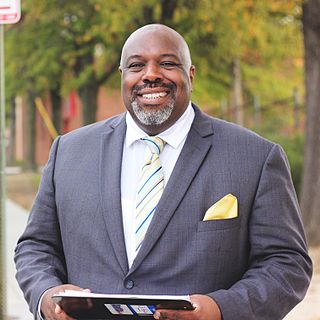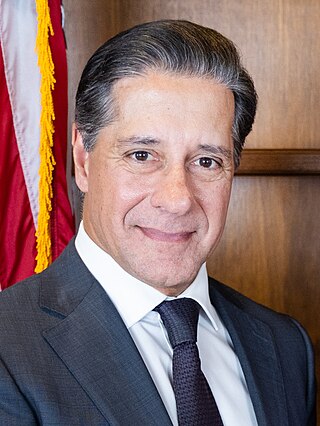Related Research Articles

The National Education Association (NEA) is the largest labor union in the United States. It represents public school teachers and other support personnel, faculty and staffers at colleges and universities, retired educators, and college students preparing to become teachers. The NEA has just under 3 million members and is headquartered in Washington, D.C. The NEA had a budget of more than $341 million for the 2012–2013 fiscal year. Becky Pringle is the NEA's current president.

Education Minnesota is an American trade union representing pre-K to 12 education teachers, school support staff and higher education faculty in Minnesota. It is affiliated with both the National Education Association (NEA) and the American Federation of Teachers (AFT), and is affiliated with the AFL-CIO.
A directly affiliated local union (DALU) or federal labor union is a US labor union that belongs to the American Federation of Labor and Congress of Industrial Organizations (AFL–CIO) but is not a national union and is not entitled to the same rights and privileges within the Federation as national affiliates.

The American Educational Research Association is a professional organization representing education researchers in the United States and around the world. AERA's mission is to advance knowledge about education and promote the use of research in educational practice.

New York State United Teachers (NYSUT) is a 600,000-member New York state teachers union, affiliated since 2006 with the American Federation of Teachers (AFT), the AFL–CIO, and the National Education Association (NEA). NYSUT is an umbrella group which provides services to local affiliates in New York state; lobbies on the local, state and federal level; conducts research; and organizes new members.

The National Catholic Educational Association (NCEA) is a private, professional educational membership association of over 150,000 educators in Catholic schools, universities, and religious education programs. It is the largest such organization in the world.

The American Student Dental Association (ASDA) is a national student-run organization that is concerned with the rights, interests, and welfare of dental students. It has the aim of introducing students to lifelong involvement in organized dentistry and provides services, information, education, representation, and advocacy.
The Ohio Federation of Teachers (OFT) is a statewide federation of unions in Ohio, affiliated with the American Federation of Teachers (AFT), AFL–CIO.

The National Alliance of Black School Educators (NABSE) is a non-profit organization that is devoted to furthering the academic success for the nation's children, especially those children of African ancestry. The NABSE was founded in 1970 and is the nation's largest network of African American educators program. The current conference and membership director is Ed Potillo. The organization reaches out to over 5,000 educators including teachers, administrators, superintendents and also other corporate and institutional members. The NABSE is dedicated to improving both the educational experiences and accomplishments of African American youth through the development and use of instructional and motivational methods that increase levels of inspiration, attendance and overall achievement. The NABSE promotes programs that deal with professional development, information-sharing on strategies that will help to motivate African American youth and increase their academic performances, and policy advocacy.

The Florida Education Association (FEA) is a statewide federation of teacher and education workers' labor unions in the US state of Florida. Its 145,000 members make it the largest union in the state. It is a merged affiliate of the American Federation of Teachers (AFT) and the National Education Association (NEA), and is a member of the AFL–CIO.
The American Association of School Administrators (AASA), founded in 1865, is the professional organization for more than 14,000 educational leaders across the United States. AASA's members are chief executive officers and senior-level administrators from school districts in every region of the country, in rural, urban, and suburban settings. AASA's mission is to support and develop effective school system leaders who are dedicated to the highest quality public education for all children. AASA publishes the magazine School Administrator.

Kappa Delta Pi (KDP), Honor Society in Education, was founded in 1911. KDP was one of the first discipline-specific honor societies. Its membership is limited to the top 20 percent of those entering the field of education.
Gladys Noel Bates was an African-American civil rights pioneer, and educator who filed a lawsuit, Gladys Noel Bates vs the State of Mississippi, in 1948 charging salary discrimination against black teachers and principals. Although her lawsuit was not successful, it brought enough attention to the issue of wage equality in education to begin to equalize salaries.
Association of American Educators (AAE) is a national, non-union, non-partisan professional educators association in the United States and is the fastest-growing association of its kind. Its stated mission is to “advance the profession through personal growth, professional development, teacher advocacy and protection.” AAE also seeks to “promote excellence in education so that [teachers] receive the respect, recognition and reward they deserve.” AAE is officially nonpartisan. AAE is not a union or a lobbying organization, but licensed as a 501(c)(6) professional trade association. AAE is funded by dues from thousands of members located in all fifty states and the District of Columbia and by contributions to the AAE Foundation, a 501(c)(3) charitable organization. AAE claims to “help lead a coalition of nearly 300,000 teachers across the country who have joined a non-union teacher association.”

Missouri State Teacher Association (MSTA) is a state teachers association that serves more than 46,000 educators in the U.S. state of Missouri and is dedicated to educating the state's children. The headquarters is located in Columbia, Missouri in the Missouri State Teachers Association Building, which is on the National Register of Historic Places.

The International Zoo Educators Association (IZE) is a non-profit organization dedicated to improving the education programmes in zoos and aquariums.

Alberto M. CarvalhoMedM is a Portuguese-American educator and the superintendent of the Los Angeles Unified School District. He previously served as superintendent of Miami-Dade County Public Schools (M-DCPS), the fourth-largest school district in the United States, with over 346,000 students and 52,000 employees. He was appointed superintendent in September 2008. In February 2014, the American Association of School Administrators (AASA) named Carvalho the 2014 National Superintendent of the Year. On February 28, 2018, New York City Mayor Bill de Blasio named Carvalho as the city's next Department of Education Chancellor, but he refused the offer the following day.
The Palmetto Education Association was a professional association and teachers' union representing teachers in all-black schools in South Carolina during racial segregation in the United States.
LaTonya M. Goffney is the superintendent of the Aldine Independent School District (AISD), which serves nearly 70,000 students in North Houston and is one of the largest school districts in the state of Texas. She previously served as superintendent of the Lufkin Independent School District and the Coldspring-Oakhurst Consolidated Independent School District.
The Palmetto State Teachers Association( PSTA) is the largest professional organization for educators in the U.S. state of South Carolina. PSTA was founded in 1976 as a non-profit organization and currently has 12,500 member teachers.